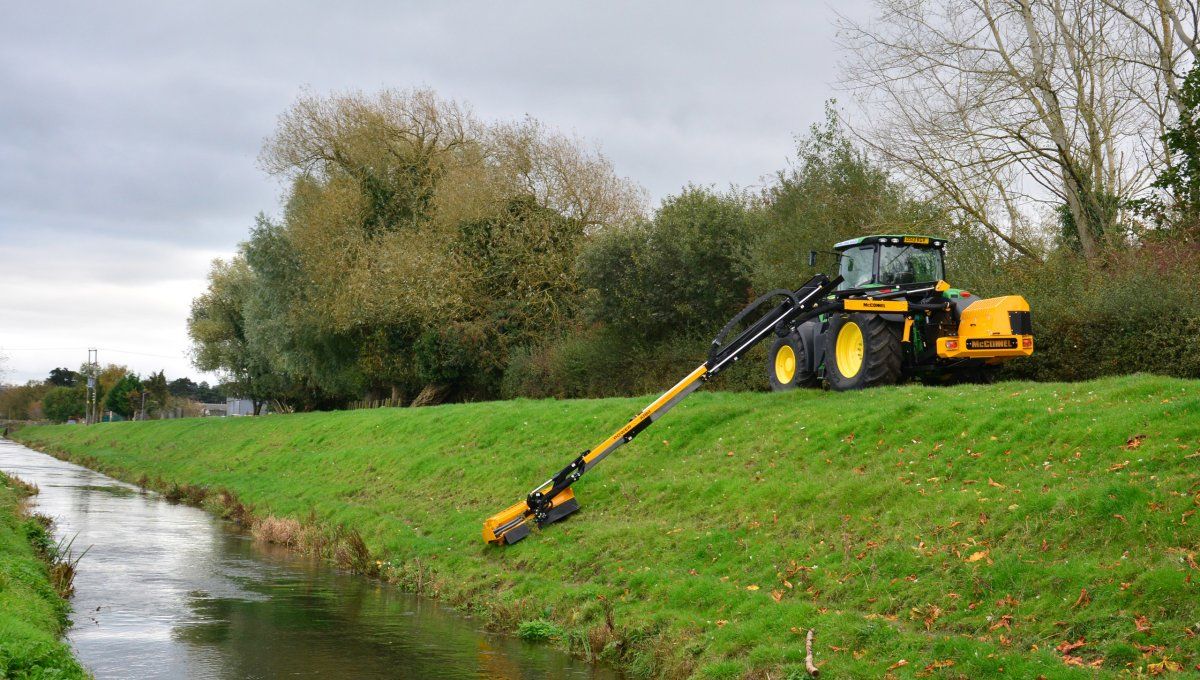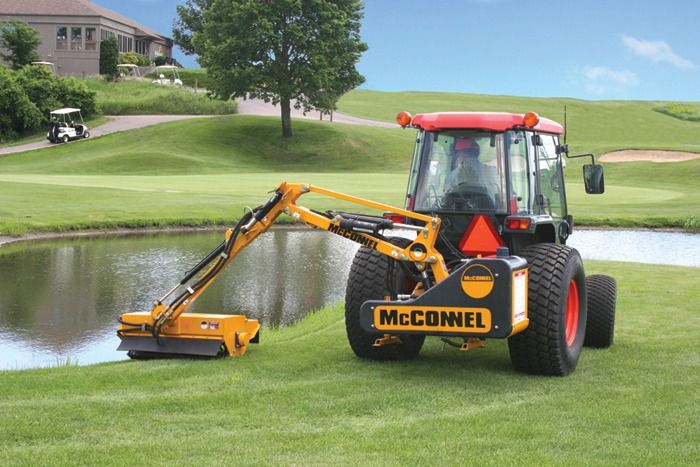AgriQuip’s top 10 tractor-mounted Hedge Cutter maintenance tips
Just like any other piece of agricultural equipment, a tractor-mounted hedge cutter requires ...
Read more
Just like any other piece of agricultural equipment, a reach mower requires regular maintenance to stay in tip-top shape. Without it, there’s a strong likelihood that your reach mower will start underperforming and developing problems as time goes on. Being an integral part of any landscaping, farming, or council operation it’s crucial to protect and maintain your investment. But how do you properly maintain a reach mower?
We’re explaining all things related to reach mower maintenance, from the gearbox to pins and bushes, and power supply loom checks. We understand that everyone gets busy and it’s easy to forget or skip a service from time to time, which is why we’ve compiled our top 10 reach mower maintenance tips to simplify the job as well as save you time. These key maintenance tips will ensure the longevity and optimum functionality of your specialist equipment. So, before you crack out the mower this season, be sure to read our top 10 reach mower maintenance tips below!

This crucial machine component requires some routine maintenance to ensure it has a trouble-free life. This involves greasing both ends of the PTO shaft weekly, as well as greasing the PTO shaft tubes regularly. It’s also important to check the universal joint bearing journals for roughness or slackness and to replace them if necessary.
You must always check the oil level before use and top up if necessary. Once you’ve completed this initial check, we recommend draining and replacing the oil after the first 50 hours of work and thereafter every 500 hours or 6 months, whichever is earlier. This will help to prolong the life of your machine. Another pro tip is to look for metal filings when draining the oil - if there is a large amount (roughly a teaspoon per litre) we would highly recommend replacing the bearings as this is a sign the bearings are failing.
We strongly advise against operating your reach mower with the cutting unit vibrating. This is because the vibration of the rotor shaft will cause premature failure of the rotor shaft bearings, as well as hydraulic and structural failures. To check the rotor for any damaged or missing flails, ensure the tractor engine is off and the PTO is disengaged, then place the head in a vertical position on the ground and support it safely. In this position, it is safe to check for damaged or missing flails and replace them if necessary.
Another key tip is to replace missing or worn flails in pairs opposite each other to maintain shaft balance. A new flail must always have a new retaining bolt, locknut, and spring washer, so it’s a good idea to check the retaining bolts are in good condition. If any are found to be bent or in poor condition, always replace the bolt locknut and spring washer together.
Check the securing locknuts are tight. If any nuts are loose, do not re-tighten the old locknut. Always replace it with a new locknut and spring washer and re-tighten. The reason you need to replace them is that locknuts deform once on the fitting to provide a torque-off resistance which is an additional defence against vibrational unscrewing. If the nut is subsequently re-tightened, this protection is lost leaving only the spring washer to prevent the nut from vibrating off.
If any flails were missing or loose and have been replaced or tightened, we recommend running the rotor and retesting for vibration. If vibration is still present, check the rotor shaft bearings for roughness or slackness and replace them if either symptom is found. If vibration persists it is an indication that the rotor shaft is probably bent and must therefore be replaced.
Rotor shaft hub failure can usually be attributed to rotor misalignment caused by a distortion of the flailhead. This occurs when the hood or casing receives a violent blow against an obstruction during work or by dropping the flail head heavily to the ground, which is more common than you’d think. That’s why it’s important to check and ensure your rotor shaft is aligned.
To realign the rotor shaft you must shim one end of the rotor with shimming washers between the bearing housing and the flailhead casing until the rotor runs true with no tight spots or binding when it is turned by hand. This procedure is best carried out with the flailhead in a vertical position on the ground. For the full instructions, refer to the operator’s manual. Failure to correctly align the rotor shaft may result in the motor shaft breaking. This is why it’s important to act quickly should your rotor shaft fail.
Regularly checking drive belts for signs of premature wear due to slipping or incorrect alignment of the pulleys will ensure your machine is in fit working condition for the summer. Refer to your reach mower’s manual for instructions on how to align drive pulleys for your specific model. It’s also vital to tension belts to the recommended tension as per the operator’s manual. Do not over-tighten the belts as this may cause premature failure of the rotor shaft, motor bearings, and seals.
It's a false economy to try and make a damaged hose last a bit longer because a failure can spill a lot of oil on the road which endangers traffic, the environment, and costs you money. To reduce the risk of this happening and ensure a long life from the hoses, we recommend a check every week. This involves checking that all hoses are in good condition and there are no leaks, looking for chafing or kinks and bends that can cause the hose to wear through and leak, and replacing the hose if leaks are found.
It’s necessary to check pins and bushes regularly. If no grease appears from the pin when greasing, replace the grease nipple. However, if still no grease appears, remove the pin and clear out the grease line. It’s important to replace bushes regularly because if a pin wears through a bush, the pin will start wearing the steel around the bush which is very expensive to repair and a new bush won’t fit correctly back into it. If the machine is sloppy when operating, identify the pins that are loose inside the bush by pushing the arm or bracket by hand and replace the pin and/or bushes as soon as possible to ensure the optimum functionality of your specialist equipment.
When necessary, the wear pads can be adjusted to alleviate any excessive slack or play between the inner and outer arm. The desired clearance between the inner arm and the wear pads is 0.5mm. Also, it’s essential to ensure the inner arm is parallel inside the outer arm.
The reach mower operating controls and computers must have a quality and constant supply of electricity from the tractor battery at all times. If the plugs or wiring become corroded, frayed, or moisture gets into them, there is a risk of software or hardware faults or even total failure. This is why periodically checking all plugs, cables, and terminals for corrosion or moisture, and cleaning thoroughly (use the electrical cleaner if needed) is imperative for the long life of your machine.
To assist this, regularly check the tightness and cleanliness of the connection of the machine power supply at the battery terminals and clean with the electrical cleaner to remove any buildup of dirt and debris.
Every week or so it’s helpful to clean the oil cooler matrix with an air gun to remove dust and debris build-up. Too much build-up will restrict airflow through the matrix limiting the cooling of the hydraulic oil. If you’re working in dusty conditions this should be done more frequently to ensure your machine is operating safely and effectively.
To reduce the risk of pump cavitation, it is advisable to replace the 25-micron absolute tank breather (if fitted) on an annual basis under normal working conditions. Although, for machines operating in dry dusty environments it is recommended that replacement be increased to every 6 months.
It’s important to note that, depending on the make and model of your reach mower, the tips listed above may not be a perfect match for your specific reach mower. These tips are provided as a general guideline and should not replace professional service advice. On that note, feel free to contact the team at AgriQuip for all of your reach mower needs! Also, if your machine is already too far gone, or you’re simply in the market for a new and incredibly efficient, and durable mower, check out our range of McConnel reach mowers below!

Just like any other piece of agricultural equipment, a tractor-mounted hedge cutter requires ...
Read more.jpg?width=352&name=Major%20Swift%20Roller%20Mower%20(trailed).jpg)
One of the most crucial aspects of any agricultural and public space work is grounds maintenance. ...
Read more
Hay mowers and toppers might both cut grass, but using one in place of the other is costing you ...
Read moreStay updated with our blog and keep in the loop with new products and everything you need to know about Agriquip.